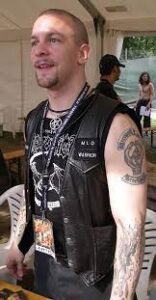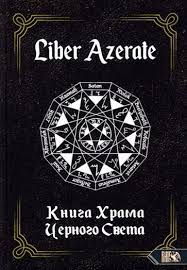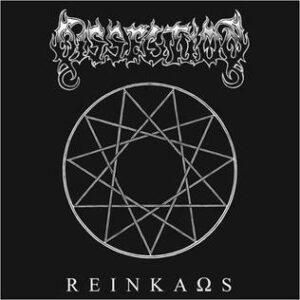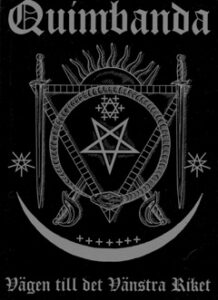MISANTHROPIC LUCIFERIAN ORDER TIMELINE
1975: Jon Nödtveidt was born.
1977: Shahin Khashnood-Sharis, also known as “Nemesis” or “Vlad”, was born.M
1980s: Khashnood-Sharis moved to Luleå, Sweden from Iran with his mother.
1990s: Khashnood-Sharis moved to Gothenburg.
1995: Misanthropic Luciferian Order (MLO) was formed.
1997: Several members, including some founding members, left MLO.
1997 (July 23): Josef Ben Meddour was murdered in Keiller’s park, Gothenburg, Sweden.
1997: Khashnood-Sharis met his girlfriend, who joined the group.
1998: Khashnood-Sharis and Nödtveidt were arrested and convicted of murder.
2002: Liber Azerate was published.
2004: Khashnood-Sharis and Nödtveidt were released from prison.
2006: The band Dissection released the album Reinkaos.
2006 (August 13): Jon Nödtveidt committed suicide.
2006: Misanthropic Luciferian Order changed its name to Temple of Black Light.
2006: Quimbanda: Vägen till det vänstra riket (Quimbanda: The Road to the Left Hand Kingdom) was published.
2008 – 2013: Liber Falxifer Book I, Book II, and Book III were published.
2013: The Book of Sitra Achra was published.
FOUNDER/GROUP HISTORY
In Gothenburg, in 1995, Misantropiska Lucier Orden (The Misanthropic Luciferian Order, MLO) was formed by a handful of Black Metal enthusiasts. The founding members were Shahin Khashnood-Sharis and two of his friends (who shall remain anonymous for reasons made clear below). Khashnood-Sharis was born in the year 1976 in Iran. He emigrated to Sweden together with his mother at a young age and was raised in Luleå in the far north. Classmates have described him as showing interest in Black Metal, Satanism and  occultism already in his teens (Hilton 2005:202–04). The family moved to Gothenburg in the early nineties when Khashnood-Sharis was a young adult, and it was here that MLO was first envisioned. Khashnood-Sharis changed his name to Nemesis, but also called himself “Vlad,” “N.A-A.218” and “Father Nemidial.” He was most likely always the front-runner and group leader, even though the hierarchy of MLO was originally intended to be egalitarian (Hilton 2005:190). Jon Nödtveidt (1975–2006), [Image at right] the guitarist of the Black Metal band Dissection, joined the group early in its history. Originally from a small town a few hours from Gothenburg, Nödtveidt had always been interested in music and Black Metal became a passion. He joined the True Satanist Hord, a group of Black Metal enthusiasts who experimented with extreme forms of metal music and occultism. Nödtveidt was later introduced to MLO and Khashnood-Sharis by a mutual friend, one of MLO’s original members (Bogdan 2016:490–91; Hilton 2005:187). Khashnood-Sharis and Nödtveidt quickly became close, inseparable, and they made up the core of the group.
occultism already in his teens (Hilton 2005:202–04). The family moved to Gothenburg in the early nineties when Khashnood-Sharis was a young adult, and it was here that MLO was first envisioned. Khashnood-Sharis changed his name to Nemesis, but also called himself “Vlad,” “N.A-A.218” and “Father Nemidial.” He was most likely always the front-runner and group leader, even though the hierarchy of MLO was originally intended to be egalitarian (Hilton 2005:190). Jon Nödtveidt (1975–2006), [Image at right] the guitarist of the Black Metal band Dissection, joined the group early in its history. Originally from a small town a few hours from Gothenburg, Nödtveidt had always been interested in music and Black Metal became a passion. He joined the True Satanist Hord, a group of Black Metal enthusiasts who experimented with extreme forms of metal music and occultism. Nödtveidt was later introduced to MLO and Khashnood-Sharis by a mutual friend, one of MLO’s original members (Bogdan 2016:490–91; Hilton 2005:187). Khashnood-Sharis and Nödtveidt quickly became close, inseparable, and they made up the core of the group.
Before MLO had been formed, some of the members frequented “Den Svarte Cikeln” (The Black Circle), an informal gathering of Black Metal musicians and students of occultism, gathered in the record store run by Øystein Aarseth (1968–1993), one of the founding members of the band Mayhem. The Black Metal scene in Norway had been lively since the late 1980s but become more and more erratic during the beginning of the 1990s, culminating in conflicts and violent acts such as church burnings, the suicide of the lead Mayhem singer Per Yngve “Pelle” Ohlin (1976–1991), and the murder of Aarseth in 1993 by Varg Vikernes, founder of the band Burzum. During this time Sweden experienced a Satanic scare which in many respects resembled what had been transpiring in America and Canada in the eighties, sometimes termed “the Satanic Panic” (Best et al. 1991). Reports of horrendous rituals, abductions and murders were in newspapers and TV-shows attached to an unidentified undercurrent of satanism that was said to terrorize Sweden. Even though there is a possibility that isolated incidents (like the Church burnings occurring in Norway and Sweden) could have been motivated and committed by people with sympathies for some forms of satanism, there is no evidence of any large presence of satanic groups carrying out violent acts in Sweden during this time (Hjelm et al. 2009:515–29). MLO grew out of this context, a music scene which drew much inspiration from occult ideas and symbolism, Satanism in particular (Johannesson and Klingberg 2011:336–55), and a broader cultural climate in Scandinavia where Satanism was associated with violence and disturbing rituals.
MLO never consisted of more than a handful of members. Most of them (possibly all except Khashnood-Sharis and Nödtveidt) left the group early in its history due to what has been described as internal conflicts, concerns surrounding an increasingly hostile environment and demands on members to undergo and act out violent and gruesome acts. Defected members have been reported as being harassed and threatened after leaving the group (Hilton 2005:190–92).
On July23, 1997 the Algerian migrant Josef Ben Meddaour was murdered in Keiler’s park in central Gothenburg. He had been shot in the back and the head, and had strange markings on his torso, three dots between his shoulder blades. Ben Meddaour’s boyfriend was initially arrested and suspected of the murder but was soon released (“Mordet i Keillers Park” 2013). Almost six months after the crime, the police still had no leads, but then got a tip which turned their attention to Khashnood-Sharis. His girlfriend had reported him to the authorities for domestic abuse and during questionings had said that she was in fear for her and her children’s lives. She knew first hand, she told the police, that Khashnood-Sharis was capable of murder since he had told her that he and Nödtveidt were responsible for the murder of the man who was killed during the summer that year. The police began investigating Khashnood-Sharis and in December 1997 arrested him and Nödtveidt, finding a number of weapons in their respective apartments. They were charged with the murder of Ben Meddaour. The prosecutor’s investigation showed, much thanks to Nödtveidt’s confession, that Khashnood-Sharis and Nödtveidt had run into Ben Meddaour during the evening of the July 22 after a long day of partying. They had struck up a conversation with Ben Meddaour and ended up at Nödtveidts apartment. Ben Meddaour was invited in to continue the conversation but declined. Instead, they agreed to go to a park nearby to drink beer. It is here, supposedly after having attempted to incapacitate Ben Meddaour with a stun gun, which did not have the desired effect, that Ben Meddaour was shot in the back as he attempted to run away, and then shot a second time in the head. During initial interrogations Nödtveidt had said that Ben Meddaour was a sacrifice to Satan, a statement that was later retracted (Hilton 2005:chapter 3).
Khashnood-Sharis and Nödtveidt were convicted to ten years each. Khashnood-Sharis was also convicted of three counts of assault (Gothenburg district court case B19859–97). After the murder, but before the arrest, Khashnood-Sharis had become involved with the woman who would later turn them in. He had contacted her after seeing her on a television talk show, discussing Satanism. She had appeared  soaking in a bathtub of what was said to be blood and described her admiration and love of Satan. Khashnood-Sharis and the woman became involved, and she was, most likely, part of MLO during this time. After having reported Khashnood-Sharis to the authorities the couple reunited and Khashnood-Sharis’ girlfriend supported him in court, pregnant with his child (Hilton 2005:220).
soaking in a bathtub of what was said to be blood and described her admiration and love of Satan. Khashnood-Sharis and the woman became involved, and she was, most likely, part of MLO during this time. After having reported Khashnood-Sharis to the authorities the couple reunited and Khashnood-Sharis’ girlfriend supported him in court, pregnant with his child (Hilton 2005:220).
In 2002, the book Liber Azerate [Image at right] was published, attributed to “Father Nemidial”, most likely referring to Khashnood-Sharis. It was first published online in Swedish, only later translated into various languages and made accessible in printed versions. This writing is presented as containing the tenets of MLO. Many subequal publications followed, most likely all penned by Khashnood-Sharis (see more below).
In 2004, Khashnood-Sharis and Nödtveidt were both released. Nödtveidt pursued his musical career and his  band Dissection released their third and last album Reinkaos [Image at right] on April 30, 2006. The lyrics were said to be based on Liber Azerate and MLO-beliefs. In 2006, after some public interviews concerning his music, he was reported as having said that he was planning a trip to Transylvania (said to be a designation for Hell), Nödtveidt was found in his apartment shot dead by a self-inflicted gunshot wound. Nödtveidt’s body is said to have laid in the middle of a pentagram drawn on the floor, with a book (possibly Liber Azerate) next to him (Introvigne 2016:509). Soon after Nödtveidt’s death, MLO changed its name to Temple of Black Light. Not much is known of the activities or structure of the group since then, as few studies have been conducted. However, Khashnood-Sharis has continued to published a series of books exploring the worldview and sacramental aspects of the particular form of Satanism of MLO, also termed “Chaos-Gnosticism.”
band Dissection released their third and last album Reinkaos [Image at right] on April 30, 2006. The lyrics were said to be based on Liber Azerate and MLO-beliefs. In 2006, after some public interviews concerning his music, he was reported as having said that he was planning a trip to Transylvania (said to be a designation for Hell), Nödtveidt was found in his apartment shot dead by a self-inflicted gunshot wound. Nödtveidt’s body is said to have laid in the middle of a pentagram drawn on the floor, with a book (possibly Liber Azerate) next to him (Introvigne 2016:509). Soon after Nödtveidt’s death, MLO changed its name to Temple of Black Light. Not much is known of the activities or structure of the group since then, as few studies have been conducted. However, Khashnood-Sharis has continued to published a series of books exploring the worldview and sacramental aspects of the particular form of Satanism of MLO, also termed “Chaos-Gnosticism.”
DOCTRINES/BELIEFS
The group has commented on its relation to Satanism and described it as being opposed to the “vulgar” versions of Satanism which evolved in America, i.e. Anton Lavey’s Church of Satan (Linjamaa and Olsson 2023:30–31). MLO has nonetheless stated that “we indeed do venerate and serve the Cause of Satan/Lucifer/Samael.” This statement is interpreted to mean as opposed to other forms of Satanism who only use Satan as a symbol (Ixaxaar publications 2011).
MLO is to be considered as part of “Left Hand Path current,” which MLO members have themselves also stated (Hilton 2005:275). The Left Hand Path is a category encompassing a large number of different initiatory groups and occult ideas. At the heart of it can be said to be the pursuit of the individual’s spiritual progress and the procurement of selfish gains through dark magic, as opposed to white magic which rather seeks to achieve selfless results through magic (Granholm 2009:85–101; Senholt 2012:250–74). MLO can be further understood as a certain version of the Left Hand Path occultism, one which practices worship of demons and destructive forces, as well as the glorification of violence (Linjamaa and Olsson 2023:34). One aim is to work toward the destruction of the structures of contemporary society and the introduction of new hierarchies over which they possess control. MLO see it as its right to govern other people, being superior in both intellect and spirit. As scholar of religion Frederik Gregorius has described it, there are aspects of Nietzschean and National Socialistic ideals imbued in the versions of Satanism common in the Black Metal scene of Norway and Western Sweden in the early 1990s. Some people are viewed as superior to others since they have an inborn right to command and take advantage of other people of lower standing, due to their intelligence and spiritual maturity (Hilton 2005:195).
MLO has described its ideology as “Chaos-Gnosticism,” which can be understood to be an interpretation of the beliefs attached to ancient Christian heresies discussed in the writings of the Church Fathers of the second to fourth century. Ancient Gnostics had nothing to do with Satan or his veneration, but rather viewed the world as created by a lower power, not God. Similarly, MLO views the world as a lower representation of a higher form of existence. The structures of society we see now are meant to control and suppress the chaotic and powerful spirit which some people have been granted. It is the aim to reawaken and let lose this primordial dark power within. While Gnostics rather viewed the human spirit originating with God and a heavenly restful and calm state (in line with Middle and Neo-Platonic thought) MLO has turned these ancient ideas on their head and views the original nature of the human soul as originating from a chaotic state of being. The goal is to return to this original state of Chaos, a creative and limitless turmoil of infinite power.
MLO’s religious beliefs are expressed in several books. Liber Azerate was the first (2002), only published several years after the group had virtually disbanded due to the incarceration of its key members. This text is where the group’s principles are most clearly stated, for example in what is termed “Den sataniska trosbekännelsen” (The Satanic confession of faith) (Liber Azerate 2002: 13). At the very beginning of the text, it states that (Liber Azerate 2002: 13, author’s translation):
I confess Satan, the wrathful God of Chaos, as my king and father and submit myself only to his law, which is total lawlessness.
I believe in one truth, which is beyond all forms and a word which will destroy the lie: that word is Wisdom.
I believe in the cause and its goal, which is the conversion of eons, and I am willing to sacrifice my enemies’ and if need be, my own blood for the cause, to expediate the establishment of the new age.[Jag erkänner Satan, det vredgade kaosets gud, som min konung och fader och underkastar mig endast hans lag, som är total laglöshet.
Jag tror på en sanning, den som är bortom alla former och på ett ord som skallförgöra lögnen: det ordet är Visdom.
Jag tror på kampen och på dess mål, som är eonskifte och är därför redo att offramina fienders och om nödvändigt mitt eget blod, för att påskynda inledandet av den nya tidsåldern]
The “cause” which is mentioned refers to the liberation of the true nature of the human soul (the “dark light” within), which is being restricted and controlled by the present eon and its embodied state. This is achieved through channeling, opening portals to and strengthening the a-causal order which reigned primordially. Causality, structure and regulations are basic forms of the present eon’s order, which are seen as contrary to the true nature of limitless Chaos. The worldview presented in Liber Azerate is full of gnostic references. The present eon is viewed as controlled by the Demiurge (Jahve) and his seven Archons, identified with the seven planets and the Sumerian gods. Cosmos is managed through causality and through limiting existence to the three corporate space dimensions and one linear time dimension. Over the centuries the dark Chaos has pierced through conventional myth and religion in different ways, always described as evil by the powers that be, like Satan or the Babylonian dragon goddess Tiamat, who is destroyed by the other Sumerian gods to establish the world of order.

In 2006, the book Quimbanda: Vägen till det vänstra riket (Quimbanda: The Road to the Left Hand Kingdom) [Image at right] was published at Lux Absconditus Publishing, and a few years later, between 2008–2013, three books of the Liber Falxifer series were published. These contain different interpretations of folklore and various religious traditions interpreted in light of MLO’s Chaos Gnosticism. Another book associated with MLO’s “Chaos-Gnsoticism,” was published in 2013. The Book of Sitra Achra is described as a grimoire, also containing reinterpretation of the genesis story (in a similar way as Book II in the Liber Falxifer-series). MLO employs many references to gematria, numerology and kabbalah. For example, the number 11 is important. Azerate is the name of the principle guiding Sitra Achra (“the Other Side”), the numerological value of which (Azrat) is 218. (Chaos-Gnosticism is also called “Current 218”). The three numbers added together total 11, the number symbolizing Chaos (the number beyond 10, i.e., order). In later publications and interviews, the numerical value 182 is also highlighted, suggesting a change in the view of the nature of principle Azerate.
The totality of MLO’s bibliography is hard to treat as representing a structured or fixed theology, but is rather dynamic and evolving. As such, it is not unlike other newly formed religions. The worldview is imbued with references to a long line of ancient religions, Kabbalah, Gnosticism, Hermeticism, Mesopotamian religion, as well as more contemporary forms of occult traditions, like the Hermetic Order of the Golden Dawn and the Order of Nine Angles. The above-mentioned texts contain a conglomerate of different and reinterpreted mythologies and philosophies, a plethora of ritual instructions and sacramental manuals. The books are authored in the name of several different authors: Frater Nemidial, N.A-A.218, Frater Asath-Anatos, and many other pseudonyms, all of which are probably Khashnood-Sharis (Introvigne 2016:509).
RITUALS/PRACTICES
Little is known with certainty of MLO’s ritual activities. Most likely their ritual practice has been experimental. It has been that blood rituals and animal sacrifices have been part of the practices, as well as incantations and summonings of various demonic powers. The goal has chiefly been the development of the members’ spiritual progress, harnessing and strengthening the inner dark and chaotic fire within, “the black flame.” According to the journalist Johan Hilton who has conducted interviews with members of the group, to become an MLO member one had to undergo an initiation ritual consisting of the ritual sacrifice of five cats (Hilton 2005:190). When search warrants were carried out at Nödtveidt’s at Khashnood-Sharis’ apartments, altars were found; they were described as tables covered with black sheets on which knives, metal cups and animal bones of different kinds were placed. An aged human skull was also found. Apart from sacrificing cats, goats have also been reported to have been ritualistically killed. Human blood has also played a role, collected as well as consumed (Hilton 2005:chapter 3). In MLO writings, a myriad of different rituals and initiatory instructions are described, with varying detail, such as “Invocation Of The Seven Evils,” “Lilith’s evocation ritual,” “The qliphothic mass,” “Pentagram-ritual,” “Dark sex-magic,” “The satanist alchemy of five steps,” “Self-initiating,” and many more. It is unclear to what extent the large number of rituals, spells and incantations mentioned in MLO writings have been practiced.
ORGANIZATION/LEADERSHIP
The group has most likely never consisted of more than a handful of people. The unofficial leader of MLO has always been Khashnood-Sharis, but Nödtveit was, during the few years he was engaged in the group in the 1990s also a leading figure. Other members who have come and gone during the years must be considered as peripheral in comparison. Khashnood-Sharis has been called the group’s “Magister Templi,” but what this role entailed in detail is unclear. Recruitment has chiefly been achieved through personal contacts with friends, partners, and acquaintances.
ISSUES/CHALLENGES
MLO is a marginal group, only consisting of a few people at any time. Its influence and importance should thus not be overestimated. Nevertheless, it has undoubtedly had some influence on different contemporary subcultural milieus, in different sub-genres of the Black Metal scene as well as in the sinister versions of the Left Hand Path (Johannesson and Klingberg 2011:336–54). Due to the marginal nature of the group and the lack of actual research on the social setting of the group, the sources are scarce and often hard to verify. What is more, the eclectic nature of the many publications that have been released over the years are hard to assess and fit into a cohesive worldview or theology. MLO’s ideology could be viewed as organic and constantly evolving.
One should consider the violent nature of MLO’s ideology, which glorifies violence, cruelty and death. To what extent the heinous acts committed by MLO members have actually been fueled by their sinister beliefs and worldview is hard to determine, but it cannot be ruled out. As investigations have shown, the killing of Josef Ben Meddaour could be described as a hate crime, as both Khashnood-Sharis and Nödtveidt have reported feeling disgust with Ben Meddaour due to his sexual orientation. To what extent the killing was motivated by MLO beliefs or as a result in extreme homophobia, therefore, is hard to determine. The ideas and practices attached to MLO should not be romanticized, but viewed and studied as a problematic and potentially dangerous undercurrent of a sinister version of contemporary Satanism (Senholt 2012:250–74).
IMAGES
Image #1: Jon Nödtveidt
Image #2: Cover of Liber Azerate.
Image #3. Cover of the album Reinkaos.
Image #4: Cover of Quimbanda: Vägen till det vänstra riket (Quimbanda: The Road to the Left Hand Kingdom).
REFERENCES
Best, Joel, David G. Bromley, and James T. Richardson. 1991. The Satanism Scare. New York: Routledge.
Bogdan, Henrik. 2016. “Satanism in Sweden.” Pp. 489–93 in Western Esotericism in Scandinavia, edited by Henrik Bogdan and Olav Hammer. Leiden: Brill.
Granholm, Kennet. 2009. “Embracing Others than Satan: The Multiple Princes of Darkness in the Left-Hand Path Milieu.” Pp. 85–101in Contemporary Religious Satanism: A Critical Anthology, edited by Jesper A. Petersen. London: Ashgate.
Hilton, Johan. 2006. No Tears for Queers: Ett Reportage om Ma ̈n, Bo ̈gar och Hatbrott. Stockholm: Bokförlaget Atlas.
Hjelm, Titus, Henrik Bogdan, Asbjørn Dyrendal, and Jesper Agaard Petersen. 2009. “Nordic Satanism and Satanism Scares: The Dark Side of the Secular Welfare State.” Social Compass 56:515–29.
Introvigne, Massimo. 2016. Satanism: A Social History. Leiden: Brill.
Ixaxaar publications. 2011. Interview with N.A-A.218, October 31. Accessed from http://www.ixaxaar.com/ 218-interview-2.html on 29 September 2023.
Johannesson, Ika and Jon Jefferson. 2011. Klingberg, Blod, Eld, Död: En Svenska Metalhistoria. Stockholm: Alfabeta.
Linjamaa, Paul and Johnny Olsson. 2023. “Chaos Untold: The Use of Gnosticism in the Misanthropic Luciferian Order (MLO).” Nova Religio 27:29–50.
”Mordet i Keillers park.” 2013. P3-documentary (Swedish Radio) March 24. Accessed from https://sverigesradio.se/avsnitt/mordet-i-keillers-park Retreaten on 1 October 2023.
Senholt, Jacob C. 2012. “Secret Identities in the Sinister Tradition.” Pp. 250–74 in The Devil’s Party: Satanism in Modernity, edited by Per Faxneld and Jesper Petersen. OxOford: Oxford University Press.
Verdict in case B 19859–97, Gothenburg district court.
Publication Date:
30 September 2023
